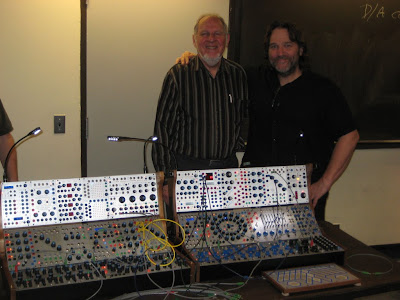via Primus Luta
"This friday Syracuse University will be taking the subject of sound sampling head on for Replay: Symposium on Sound Sampling (http://sampling.syr.edu).
From the website:
"A distinguished panel—including a world renowned copyright expert; musicians who use sampling in their compositions; an academic expert; and a record label representative—will participate in a series of structured conversations about the law, business, technology, theory, and culture of sampling recorded sound. The event will also feature a live demo of sampling from the Belfer Audio Archive. The program will also be professionally filmed and simulcast on the Web."
The morning sessions will focus on the business and legal side of sampling with panelists including Google's Copyright Counsel and the founder of Illegal Art. Then afternoon will turn toward the creative side of things, with a sampling presentation by AvantUrb's Primus Luta and then in a discussion between him and Hank Shocklee from the Bomb Squad on creative innovation with sampling.
In a recent interview
(http://blog.gnarlee.net/primus-luta-is-comin-clean-exclusive-intervie),
Primus Luta explained:
"The folk from Syracuse contacted me based on my work in creating a notation system for sampling and its implications for a legal argument. They are really trying to use the symposium as a stepping stone for addressing these issues head on. It's been a buzz topic for a couple of years now, and so there are documentaries and panels at music conferences on the subject. With all of these things though few if any solutions have been offered. That's what really makes this symposium special, its not just hey lets talk about it, it's hey lets find a solution for it."
The full day will be broadcast on the web. To watch and participate you will need to register online (http://sampling.syr.edu/register.php). If you cannot watch the live broadcast, all of the day's events will be documented and posted on the Syracuse site shortly after the event."

Wednesday, April 07, 2010
Gas 0095 Studio - name that synthesizer, win a CD
YouTube via microscopics — April 06, 2010 — Gas studios around 1999. Name that gear, win the Gas 0095 CD.
http://microscopics.co.uk
The video is quite blurry, so its a good way to test your synthesizer geeking skills.
Name the gear in the comments or on our blog http://www.microscopics.co.uk/blog/ and we'll send three copies of Gas 0095 on CD + MP3 + Flac24 to the three geeks who guess/ identify the most gear correctly.
This is most of the gear used to record the Gas 0095 album, with a few additions and subtractions.
Each copy of Gas 0095 on CD or flac bought from us comes with a FREE Minimoog model
http://microscopics.co.uk"
AELITA 3-VCO RARE VINTAGE SOVIET ANALOG SYNTHESIZER
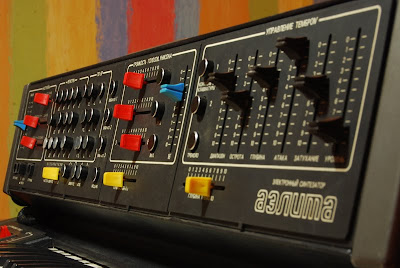
via this auction
video by jexus here
"AELITA is a 3-oscillator monophonic synthesizer with 44 keys, produced by the Murom radio plant in USSR in eighties. The device is housed in a strong aluminum body. Sound control is performed with handy faders and buttons. The synth has really impressive analog sound - it is convenient for modeling of fat analog basses, classic rock leads, hard razor waves, various space FX`s, noises, ambient textures and much more... It is able to form both hard and soft timbres. By activating the UNISON function, the number of simultaneously sounding voices may be 5 or 6. Because you can detune the three independent oscillators, it is possible to create "one finger chord hits".
 The Aelita synthesizer consists of 5 basic synthesis sections, which are the following: TUNING, REGISTERS/TIMBRE (osc wave switch), UNISON/VOICE LEVEL, TIMBRES CONTROL (filter), VOLUME CONTROL (amplifier). A wide range of modulation functions are available, including RING MODULATION. The synthesizer provides a three oscillator voice, with the addition of unison function, which adds extra timbres to basic sound. Respectively, there are separate controls for all oscillators in all sections.
The Aelita synthesizer consists of 5 basic synthesis sections, which are the following: TUNING, REGISTERS/TIMBRE (osc wave switch), UNISON/VOICE LEVEL, TIMBRES CONTROL (filter), VOLUME CONTROL (amplifier). A wide range of modulation functions are available, including RING MODULATION. The synthesizer provides a three oscillator voice, with the addition of unison function, which adds extra timbres to basic sound. Respectively, there are separate controls for all oscillators in all sections. The TUNING section provides the "global tuning" and separate DETUNE 1/2/3 knob for each oscillator. Below the section, three parameter buttons are situated: RELEASE, UNISON/VOICE and STRINGS. By pressing RELEASE, the "preset released" mode is activated independently of the RELEASE slider in the AMPLIFIER section. Next the UNISON/VOICE ON/OFF button - having entered the mode UNISON ON you will get aggressive layered strings sound (see demo sample1). By pressing the STRINGS button, you actually activate the modulation function, which imitates stringed instruments vibrato; but in conjunction with the UNISON ON mode, it provides "strings" sound with a complex modulated timbre.
The TUNING section provides the "global tuning" and separate DETUNE 1/2/3 knob for each oscillator. Below the section, three parameter buttons are situated: RELEASE, UNISON/VOICE and STRINGS. By pressing RELEASE, the "preset released" mode is activated independently of the RELEASE slider in the AMPLIFIER section. Next the UNISON/VOICE ON/OFF button - having entered the mode UNISON ON you will get aggressive layered strings sound (see demo sample1). By pressing the STRINGS button, you actually activate the modulation function, which imitates stringed instruments vibrato; but in conjunction with the UNISON ON mode, it provides "strings" sound with a complex modulated timbre. The REGISTERS/TIMBRES section contains the timbres range (octave registers) 2`, 4`, 8`, 16`, 32` buttons and the WAVEFORM SELECT buttons (square, triangle and saw). The MODULATION/LFO FREQ slider, also called VIBRATO/TREMOLO, is situated below; four LFO WAVEFORMS selection buttons are situated at the lowest.
The REGISTERS/TIMBRES section contains the timbres range (octave registers) 2`, 4`, 8`, 16`, 32` buttons and the WAVEFORM SELECT buttons (square, triangle and saw). The MODULATION/LFO FREQ slider, also called VIBRATO/TREMOLO, is situated below; four LFO WAVEFORMS selection buttons are situated at the lowest.Between the REGISTERS and VOLUME CONTROL sections, the MODULATION switch buttons for all oscillators (called VIBRATO 1/2/3) and the button MOD1*3 activating frequency modulation of the first voice with the third one; actually, this is the RING MODULATION mode. Combined activation of the buttons MOD1*3and UNISON/STRINGS makes it possible to get a uncommon compound timbre of sound. The section UNISON/VOICE LEVEL contains three sliders 1/2/3/ and three buttons for controlling the volume level and for switching the oscillators ON and OFF. One of the sliders is designed to control the UNISON level in the range 16í. With the button UNISON/VOICE at ON, the sliders 1/2/3 perform the function of controlling the UNISON level of the registers in the ranges 2í, 4í, 8í. Below the section, the MODULATION DEPTH (vibrato) slider is located.
The TIMBRES CONTROL section has two buttons in the left part: KEY TRACKING ON/OFF and LFO (tremolo on/off). Near the buttons, 6 filter control sliders are situated, those are the following: FILTER CUTOFF (called RANGE), RESONANCE (SHARPNESS), MOD DEPTH, ATTACK, SUSTAIN/RELEASE, DECAY (called LEVEL). Below the section is the TREMOLO DEPTH. The VOLUME CONTROL (AMPLIFIER) section provides the following functions: ATTACK, SUSTAIN / RELEASE, DECAY (called LEVEL), MAIN VOLUME LEVEL and controlled with the respective sliders. At the rear panel, a 5 din OUT is situated for connection of the volume control pedal or an external mixer/amplifier."
Squidfanny - Circuit Bent OMNICHORD OM-27 Demo 3 (Just the touch points)
YouTube via squidfanny — April 07, 2010 — "Demo Vid for Ebay Auction...
Just the touch points and some of the mods.
Combine the preset drum patterns to create complex Arps. Use the Glitch mods to evolve the sound and touch away...."
Omnichords on Ebay. Follow-up to this post where you'll find parts 1 and 2. Comments enabled there to keep them in one post.
Roland The Synthesizer Books 1st Edition
"This is the original version and not the second edition of Roland's The Synthesizer book that comes with all four books."
You can see the second edition for reference here.
Folktek Art The Luminist Garden
 via this auction
via this auctionSee the Folktek label at the bottom of this post for more including video of The Luminist Garden.
"The Garden is a conceptual sound art work and a phenomenal instrument for extending micro sounds into waves or generating odd sounds based on an accoustic source. The Garden is a part of the electrocoustic section of the works of Arius Blaze. Please go here to see more: http://ariusblaze.com/electrocoustic.html
This work is an expanded version of the Micro Garden, capable of making lush choral waves and entire compositions as a standalone work. The expanded soundboard has multiple pick ups that run into the delay - which offers time settings from extremely tight notated repeats to about 1.5 seconds with undecaying feedback that essentially acts as a looper allowing one to make beats by tapping the board and plucking or rubbing the strings.

The delay runs into a very lush and unusual reverb that has the ability to act more as a wave generator, creating waves that can endlessly extend and are based on the original note but with the ability to pitch shift the feedback, resulting in something like the NI effect called "convolution".
The result is rich electronic music from an accoustic source. Sweet ambience. Stereo out.
There are sound samples on the blog page: http://folktek.blogspot.com/2010/01/luminist-garden.html, each a single take with no editing or external effects.
 The feedback can be adjusted to generate long perfect extentions of micro sounds to become waves then captured in long format if desired. There is as much musical potential as there is a potential for strange sounds - bits of waves can be strecthed in real time and become distant-relative abstractions of themselves.
The feedback can be adjusted to generate long perfect extentions of micro sounds to become waves then captured in long format if desired. There is as much musical potential as there is a potential for strange sounds - bits of waves can be strecthed in real time and become distant-relative abstractions of themselves.There has not been a single displeased buyer of the any of the Garden series - it is an extremely solid conceptual work with a huge sound.
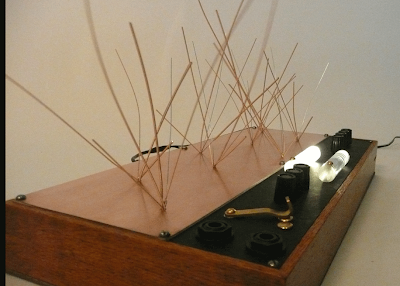 This piece runs on supplied 9v power adapter, stereo 1/4" output to amp or mixer, custom folktek hardwood box with jointery, custom lamps and switch."
This piece runs on supplied 9v power adapter, stereo 1/4" output to amp or mixer, custom folktek hardwood box with jointery, custom lamps and switch."

Folktek Art The Micro Garden
 via this auction
via this auctionSee the Folktek label at the bottom of this post for more including video.
"The Garden is a conceptual sound art work and a phenomenal instrument for extending micro sounds into waves or generating odd sounds based on an accoustic source. The Garden is a part of the electrocoustic section of the works of Arius Blaze. Please go here to see more: http://ariusblaze.com/electrocoustic.html
 The sound very much reflects the asthetic - an electric garden with waves growing from the sound field they're created from. The sound board and spouts of wire extending from it are picked up with high sensitivity and run through a digital delay with a very warm sound. This delay can be as tight as possible or extend to about one and a half seconds. Every sprig of string has a unique sound and the Garden can be played as a percussion piece or soundscape generator. The feedback can be adjusted to generate long perfect extentions of micro sounds to become waves then captured in long format if desired. There is as much musical potential as there is a potential for strange sounds - bits of waves can be strecthed in real time and become distant-relative abstractions of themselves.
The sound very much reflects the asthetic - an electric garden with waves growing from the sound field they're created from. The sound board and spouts of wire extending from it are picked up with high sensitivity and run through a digital delay with a very warm sound. This delay can be as tight as possible or extend to about one and a half seconds. Every sprig of string has a unique sound and the Garden can be played as a percussion piece or soundscape generator. The feedback can be adjusted to generate long perfect extentions of micro sounds to become waves then captured in long format if desired. There is as much musical potential as there is a potential for strange sounds - bits of waves can be strecthed in real time and become distant-relative abstractions of themselves. the buyer of a previous garden on ebay had this to say: "Garden of Eden. You have quite outdone yourself w/ the Garden ! Simple and beautiful-a great idea ! I might say it's the best of yours I have. Wonderful work!". All who have recieved these works have been quite pleased.
the buyer of a previous garden on ebay had this to say: "Garden of Eden. You have quite outdone yourself w/ the Garden ! Simple and beautiful-a great idea ! I might say it's the best of yours I have. Wonderful work!". All who have recieved these works have been quite pleased.This piece runs on a single 9v battery, 1/4" output to amp or mixer, custom folktek hardwood box with jointery, and the lamp glows white."
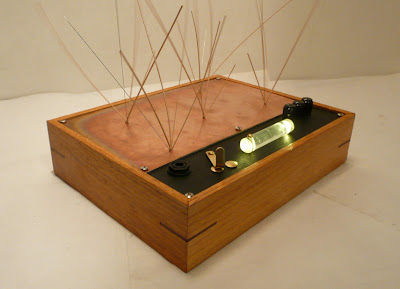
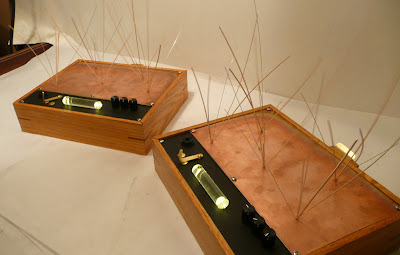
PREVIOUS PAGE
NEXT PAGE
HOME













© Matrixsynth - All posts are presented here for informative, historical and educative purposes as applicable within fair use.
MATRIXSYNTH is supported by affiliate links that use cookies to track clickthroughs and sales. See the privacy policy for details.
MATRIXSYNTH - EVERYTHING SYNTH













© Matrixsynth - All posts are presented here for informative, historical and educative purposes as applicable within fair use.
MATRIXSYNTH is supported by affiliate links that use cookies to track clickthroughs and sales. See the privacy policy for details.
MATRIXSYNTH - EVERYTHING SYNTH

